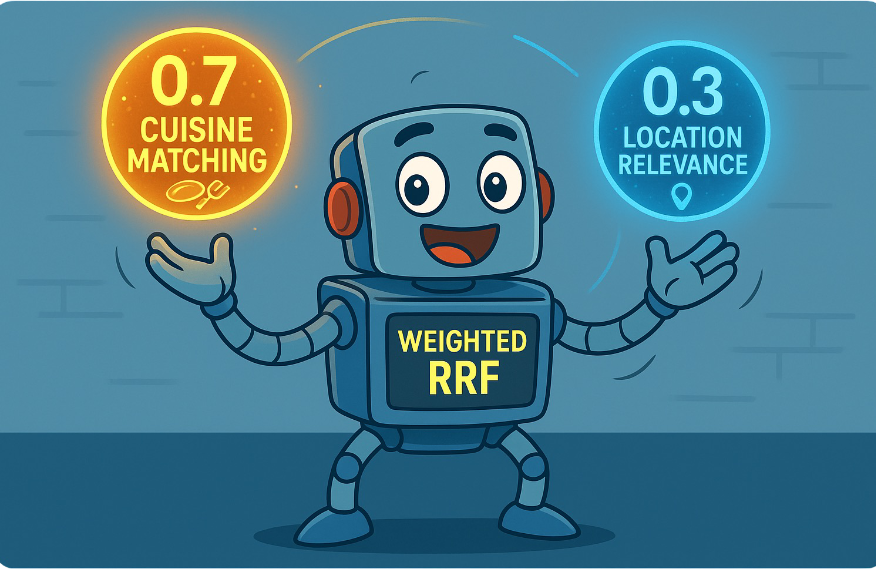In our previous blog post we introduced the redesigned-from-scratch retrievers framework, which enables the creation of complex ranking pipelines. We also explored how the Reciprocal Rank Fusion (RRF) retriever enables hybrid search by merging results from different queries. While RRF is easy to implement, it has a notable limitation: it focuses purely on relative ranks, ignoring actual scores. This makes fine-tuning and optimization a challenge.
Meet the linear retriever!
In this post, we introduce the linear retriever, our latest addition for supporting hybrid search! Unlike rrf, the linear retriever calculates a weighted sum across all queries that matched a document. This approach preserves the relative importance of each document within a result set while allowing precise control over each query’s influence on the final score. As a result, it provides a more intuitive and flexible way to fine-tune hybrid search.
Defining a linear retriever where the final score will be computed as:
It is as simple as:
GET linear_retriever_blog/_search
{
"retriever": {
"linear": {
"retrievers": [
{
"retriever": {
"knn": {
...
}
},
"weight": 5
},
{
"retriever": {
"standard": {
...
}
},
"weight": 1.5
},
]
}
}
}Notice how simple and intuitive it is? (and really similar to rrf!) This configuration allows you to precisely control how much each query type contributes to the final ranking, unlike rrf, which relies solely on relative ranks.
One caveat remains: knn scores may be strictly bounded, depending on the similarity metric used. For example, with cosine similarity or the dot product of unit-normalized vectors, scores will always lie within the [0, 1] range. In contrast, bm25 scores are less predictable and have no clearly defined bounds.
Scaling the scores: kNN vs BM25
One challenge of hybrid search is that different retrievers produce scores on different scales. Consider for example the following scenario:
Query A scores:
| doc1 | doc2 | doc3 | doc4 | |
|---|---|---|---|---|
| knn | 0.347 | 0.35 | 0.348 | 0.346 |
| bm25 | 100 | 1.5 | 1 | 0.5 |
Query B scores:
| doc1 | doc2 | doc3 | doc4 | |
|---|---|---|---|---|
| knn | 0.347 | 0.35 | 0.348 | 0.346 |
| bm25 | 0.63 | 0.01 | 0.3 | 0.4 |
You can see the disparity above: kNN scores range between 0 and 1, while bm25 scores can vary wildly. This difference makes it tricky to set static optimal weights for combining the results.
Normalization to the rescue: the MinMax normalizer
To address this, we’ve introduced an optional minmax normalizer that scales scores, independently for each query, to the [0, 1] range using the following formula:
This preserves the relative importance of each document within a query’s result set, making it easier to combine scores from different retrievers. With normalization, the scores become:
Query A scores:
| doc1 | doc2 | doc3 | doc4 | |
|---|---|---|---|---|
| knn | 0.347 | 0.35 | 0.348 | 0.346 |
| bm25 | 1.00 | 0.01 | 0.005 | 0.000 |
Query B scores:
| doc1 | doc2 | doc3 | doc4 | |
|---|---|---|---|---|
| knn | 0.347 | 0.35 | 0.348 | 0.346 |
| bm25 | 1.00 | 0.000 | 0.465 | 0.645 |
All scores now lie in the [0, 1] range and optimizing the weighted sum is much more straightforward as we now capture the (relative to the query) importance of a result instead of its absolute score and maintain consistency across queries.
Example time!
Let’s go through an example now to showcase what the above looks like and how the linear retriever addresses some of the shortcomings of rrf. RRF relies solely on relative ranks and doesn’t consider actual score differences. For example, given these scores:
| doc1 | doc2 | doc3 | doc4 | |
|---|---|---|---|---|
| knn | 0.347 | 0.35 | 0.348 | 0.346 |
| bm25 | 100 | 1.5 | 1 | 0.5 |
| rrf score | 0.03226 | 0.03252 | 0.03200 | 0.03125 |
rrf would rank the documents as:
However, doc1 has a significantly higher bm25 score than the others, which rrf fails to capture because it only looks at relative ranks. The linear retriever, combined with normalization, correctly accounts for both the scores and their differences, producing a more meaningful ranking:
| doc1 | doc2 | doc3 | doc4 | |
|---|---|---|---|---|
| knn | 0.347 | 0.35 | 0.348 | 0.346 |
| bm25 | 1 | 0.01 | 0.005 | 0 |
As we can see in the above, doc1’s great ranking and score for bm25 is properly accounted for and reflected on the final scores. In addition to that, all scores lie now in the [0, 1] range so that we can compare and combine them in a much more intuitive way (and even build offline optimization processes).
Putting it all together
To take full advantage of the linear retriever with normalization, the search request would look like this:
GET linear_retriever_blog/_search
{
"retriever": {
"linear": {
"retrievers": [
{
"retriever": {
"knn": {
...
}
},
"weight": 5
},
{
"retriever": {
"standard": {
...
}
},
"weight": 1.5,
"normalizer": "minmax"
},
]
}
}
}This approach combines the best of both worlds: it retains the flexibility and intuitive scoring of the linear retriever, while ensuring consistent score scaling with MinMax normalization.
As with all our retrievers, the linear retriever can be integrated into any level of a hierarchical retriever tree, with support for explainability, match highlighting, field collapsing, and more.
When to pick the linear retriever and why it makes a difference
The linear retriever:
- Preserves relative importance by leveraging actual scores, not just ranks.
- Allows fine-tuning with weighted contributions from different queries.
- Enhances consistency using normalization, making hybrid search more robust and predictable.
Conclusion
The linear retriever is already available on Elasticsearch Serverless, and the 8.18 and 9.0 releases! More examples and configuration parameters can also be found in our documentation. Try it out and see how it can improve your hybrid search experience — we look forward to your feedback. Happy searching!
Ready to try this out on your own? Start a free trial.
Want to get Elastic certified? Find out when the next Elasticsearch Engineer training is running!
Related content

September 15, 2025
Balancing the scales: Making reciprocal rank fusion (RRF) smarter with weights
Exploring weighted reciprocal rank fusion (RRF) in Elasticsearch and how it works through practical examples.

September 8, 2025
MCP for intelligent search
Building an intelligent search system by integrating Elastic's intelligent query layer with MCP to enhance the generative efficacy of LLMs.

Building intelligent duplicate detection with Elasticsearch and AI
Explore how organizations can leverage Elasticsearch to detect and handle duplicates in loan or insurance applications.

July 10, 2025
Diversifying search results with Maximum Marginal Relevance
Implementing the Maximum Marginal Relevance (MMR) algorithm with Elasticsearch and Python. This blog includes code examples for vector search reranking.

July 9, 2025
Semantic text is all that and a bag of (BBQ) chips! With configurable chunking settings and index options
Semantic text search is now customizable, with support for customizable chunking settings and index options to customize vector quantization, making semantic_text more powerful for expert use cases.